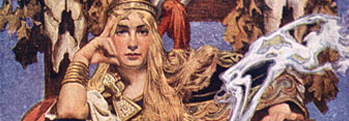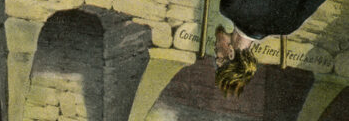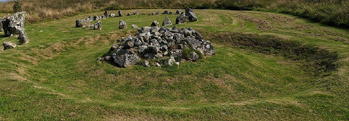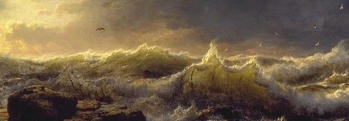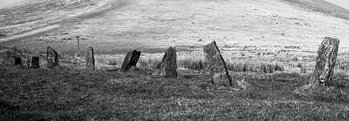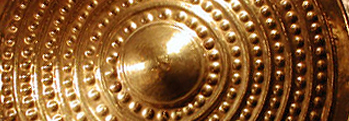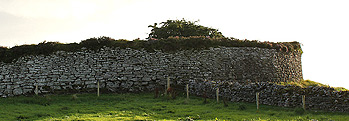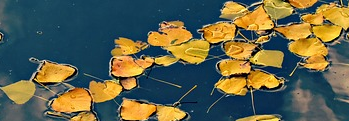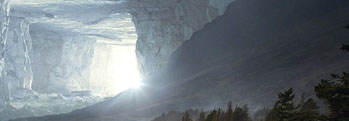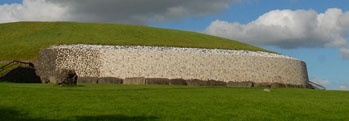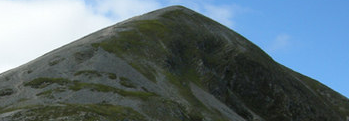Dun Aonghasa
Irish and Celtic myths and legends, Irish folklore and Irish fairy tales and Legendary Places in Ireland
The breathtaking fortress of Dún Aonghasa, perched on the edge of a steep cliff

Dún Aonghasa means "the Fort of Aonghasa", and remains one of the most impressive ancient monuments in Ireland, Europe or the world. Perched on the edge of a high and jagged cliff with the grey-green waters of the Atlantic battering below, it gained its name from its original builders, who were called the Fir Bolg, some of the first to arrive in Ireland and who strove mightily with the Tuatha de Dannan at Moy Tura.
"The Fir Bolg gave them battle upon Mag Tuired; they were a long time fighting that battle. At last it broke against the Fir Bolg, and the slaughter pressed northward, and a hundred thousand of them were slain... The Fir Bolg fell in that battle all but a few, and they went out of Ireland in flight from the Tuatha Dé Dannan...
Thereafter they came in flight before Cairbre under the protection of Medb and Ailill, and these gave them lands. This is the wandering of the sons of Umor. Oengus son of Umor was king over them in the east, and from them are named those territories, Loch Cime from Cime Four-Heads son of Umor, the Point of Taman in Medraige from Taman son of Umor, the Fort of Oengus in Ara from Oengus, the Stone-heap of Conall in Aidne from Conall, Mag Adair from Adar, Mag Asail from Asal in Mumu also. Menn son of Umor was the poet. They were in fortresses and in islands of the sea around Ireland in that wise, till Cu Chulaind overwhelmed them."
After the Fir Bolg it was reputed to have become the last refuge of the feared Fomorian sea demons as well.
Dún Aonghasa is the mightiest and most powerful of all the prehistoric stone forts of the Aran Islands. It stands today a great circle cut in two on the edge of towering cliffs, and it is likely to have once been a completely circular fort or building before erosion toppled it piece by piece into the Manannan's white-toothed jaws snapping far below.
Some archaeologists date it at well over three thousand years old, although it is difficult to be certain on such rocky terrain. It could be even older. Bronze Age and Iron Age items aplenty have been found within and around the Dún, such as rings, beads, and the remains of food, as well as evidence of ancient metalworking. Houses and burials are also dotted around nearby.
Outside the looming cyclopean fortification of the central drystone walls is a circle of jagged stones, a chevaux-de-fris which would in medieval times have been used to break up and disrupt cavalry charges. So well designed and jagged is this ancient minefield that it would be very difficult even for armoured footsoldiers to clamber over it, and even now the edges of the stones are sharp and you could do yourself a severe injury by falling atop one. Attackers would have been easy prey for archers, slingers and spearmen atop the walls or firing through arrow slits.
Originally the fortress gate was to the north and the main entrances through the outer and middle walls still face northwards. Today people can enter through a breach in the outer wall, but the older entrance is still visible. The gates were made of stout wood and had a sudden drop inside the threshold, perhaps designed to trip any unwanted visitors.
The Dún was clearly designed for both defence and as an expression of raw power. It overlooks much of the surrounding countryside, leaving no doubt about who was the master of the island, and perhaps acted as a watchtower for invaders, traders or raiders. There are in total three circular walls, one around the other, and the central enclosure may have once been a mighty roofed hall.
It is estimated that even if the original fortress consisted only of simple walls, it would have taken over six and a half thousand tons of cut stone to fully construct, which tells a tale of a strong culture and an advanced society well able to work together to achieve mighty works.
At the very heart of the ancient stronghold is a giant square stone slab, almost pefectly level platform which might have served as a foundation for a central column or pillar. Some scholars suggest that the platform overlooking the vast Atlantic ocean may have had a later ritual significance. A hoard of four bronze rings were buried beside it, perhaps as an offering or someone trying to hide valuable items, or even just left behind and forgotten by smiths.
A large hearth to one side of the inner complex seems to have been the site of communal feasting and the casting of bronze weapons and tools. Perhaps during the early Bronze Age those who knew the secrets of casting the gleaming golden metal were seen as grim sorcerers or priests who held the key to the rise and fall of kings and dynasties.
As well as beef, pork and barley, the Bronze Age Irish who built and occupied this fastness ate an enormous amount of shellfish - almost eight tons of limpet shells were recovered from the excavations - as well as fish. Curiously, many of the tools found in the locality were made of stone, perhaps indicating a community isolated from the rest of the country, or even holdovers from Neolithic groups who brought their skills with them to the Dún.
Clothes were made of wool or leather and fixed in place with pins, although the diverse range of needles found demonstrate that the Bronze Age occupants used many different materials.
The fortress was most active around 800 BC, in the midst of the Iron Age, the time of the Gaels and the Druids. It would have been the economic and political centre for one particular tribe, the leaders of whom would have occupied the Dún.
In the centuries after Dún Aonghasa fell into disuse, various houses and other buildings were constructed inside the inner enclosure, with paved floors and stone hearths. A stone trough outside the door of one of the houses was most likely used to store water, keep shellfish fresh, or to boil meat.
Various attempts were made to refortify and rebuild the site during the medieval period, from 700 to 800 AD, since the Aran Islands were a fiercely disputed territory on the frontier between the lords of Connacht and those of Munster to the south at that time. The old Bronze Age middle walls which had fallen into ruin were rebuilt to double their ancient width and height, and the other walls were also strengthened and increased.
The bodies of two young men were buried in the paved entrance to the middle wall around 680-800 AD, although there was no evidence to suggest that they died violently.
It was reconstructed after being declared a National Monument in 1880, and the large buttresses we can see outside the front of the entrance were added during that reconstruction, along with several other elements.
Dún Aonghasa still stands where it's marked on the map below.
Legendary Places in Ireland
The extraordinary Ballintubber Abbey, known as Tobar Padraic in the Annals of the Four Mastersm is almost a thousand years old, having been built by King Cathal Crobdearg Ua Conchobair - whose father commissioned the beautiful Cross of Cong - in 1216. It has survived ages and centuries of persecution and fire, providing a place for people to visit ... [more]
One of the rarest and most beautiful woods in the world is Irish bog oak. This very ancient kind of wood can be found across Ireland, but is most often recovered from deep peat bogs in the midlands, and can be anywhere from three thousand to eight thousand years old or more. These trees grew, lived and fell in times of legend, witnessing the rise o ... [more]
One of the most imposing legacies of the last of the mighty megalith-builders of the Neolithic and Bronze ages, the Dolmen of the Four Maols, considered by some to be a cist tomb rather than a dolmen or portal tomb. An enormous capstone sits above three other stones, while the entry stone lies not far off. It was once covered by a cairn of smaller ... [more]
Alone in County Louth rises a tall standing stone, its only company the ravens overhead and the whispering wind given voice by nearby trees. This is Clochafarmore, which means "the stone of the great man". It was first raised during the bronze age and rises to ove three meters in height, in a place whose name means The Field of Slaughter, ... [more]
The Boheh stone in the deepest west of Ireland is one of the finest examples of Neolithic rock art in Europe, over two hundred and fifty petroglyphs wrought by unknown hands on a natural outcrop of rock flecked with quartz stones, on the west side of a hill, facing the setting sun, around 3800 BC. Twice a year at sowing and harvest times this produ ... [more]
Cashel of the Kings, the mighty Rock of Cashel was in olden times known as the Royal Site of the Kings of Mumu, a place we today call Munster. It is a great uplifting of raw limestone from the surrounding grassy plains, which old tales tell was hurled from a mountain called the Devil's Bit, in County Tipperary. It is said to have been where ... [more]
The great northern fastness of Emain Macha means "Macha's twins" or "Macha's pair", and its tale is bound tightly with the local goddess Macha, after whom is also named Armagh, Ard Macha. The ancient Greek philosopher Ptolemy drew a map of the world, upon which he marked a place called Isamnion in southern Ulster, which ... [more]
The spiritual and geographical heart of Ireland is the Hill of Uisneach overlooking a wide plain in view of twenty counties, where the borders of all five kingdoms met, where great decisions were made and assemblies were held, the mórdáil Uisnig, and home to Ail na Mireann, or the Stone of Divisions. On the hill all around this strang ... [more]
The seat of the High Kings of Ireland stretching back to the Tuatha and the Fir Bolg, Tara or Temair as it was known then, is said to have been the seat of a hundred and forty two kings, kingships won by battle, contest and merit, not passed down father to son as in more primitive cultures. It is also known as Teamhair na Rí, 'Tar ... [more]
Dún Ailinne is one of the great Royal Sites of Ireland, "a place of assemblies, a Rath with royal roads, a Grianan or palace, and a Royal Dún", where great ceremonies, rituals and gatherings took place, seat and crowning-place of the Gaelic Kings of Leinster. All that remains of it now is a large circular embankment a ... [more]
The glorious stronghold of Rathcrogan, or Ráth Cruachan, was the Royal Site of the great Kings and Queens of the Western lands for thousands of years. Within its sacred embrace were held the thronging ceremonial assemblies or óenach, and people of every station would gather from all corners of Ireland to reach out and touch, if on ... [more]
The gift of the gab, as it’s known, is a common thing among the Irish – being able to talk all day about anything and everything, and do it in a way that would have you listen as well. It’s as Irish as red hair and freckles. But what if you didn’t have the gift of the gab, or felt a deficiency of gabbiness? Never fear, al ... [more]
The Spring equinox was a very important time for the people of ancient Ireland, heralding as it did the end of the dark season with all of its dangers and want, and signalling the dawn of a new year of plenty. The day and night, the light and the dark side of the year were in equal balance, neither stronger than the other, and it is easy to ... [more]
Ireland is a land of many treasures – some are well known while others are known only to a few, like the mysterious stone circles of Beaghmore! In the north of County Tyrone they can be found, at the edge of the Sperrin mountains looking out over the wide countryside below, dating back to the bronze age and earlier, to the time when the Tuath ... [more]
The royal ringfort of Grianán Ailigh was known as the father of every building in Ireland by the Annals of the Four Masters, who also claimed it was first built in the year 1500 BC, in the time of the Tuatha Dé Danann! A mighty place of strength it is and was and may always be, one of the few locations in Ireland correctly marked on a ... [more]
Knockma of the mists is a place wreathed in secrets and myth where they say sleeps the greatest king of the Sidhe, he whose name was Finnbheara! Should you go for a walk around Knockma Hill, pay close attention to that which you cannot see – a warm breeze meant a good fairy was passing by, and a sudden shiver meant an evil one was close! J ... [more]
Nine is a mystical number in Irish folklore, being thrice three, itself known from ancient times as a mysterious symbol, and so should you happen across nine stones, you would do well to be extra careful! For who knows what might lie sleeping just below the surface. And such a place can be found on the saddle between Sliabh Bán, the White ... [more]
Once upon a time there were many kingdoms in Ireland, and many kings, or perhaps they would have been better known as chieftains, but kings they were for all that. As time went by each of these kingdoms fell and were joined one into the other, but yet a single kingdom still remains in the farthest north and farthest west of the country, and this is ... [more]
Ireland's bones are made of stories, you can hardly step over a rock or walk past an old mound but if it could speak, it would tell you tales you could hardly imagine. But of all the legended glens and fields misty with memory in this ancient nation, there are few with as many secrets hidden in their depths as Lough Gur in county Limerick. S ... [more]
There are tens of thousands of round stone forts in Ireland, some say as many as fifty thousand, if you can believe it, and one of the finest examples we have is at Kilcashel in County Mayo, which comes from the Irish Coill an Chaisil, the woods of the stone fort. Almost perfectly circular in construction, with thick walls two broad men could walk ... [more]
Scattered throughout the Irish countryside are hundreds if not thousands of holy wells, almost all of great antiquity, even predating Christianity. They can take almost any form and show up in any place, shimmering in the shadow of engraved stone monuments, in lapping sea caves where the fresh and salt waters mingle twice a day, as natural springs ... [more]
In county Roscommon there's a place of great antiquity called Oweynagat, which some have mistakenly thought to mean the Cave of Cats, although it has nothing to do with cats - “cath” being the Irish word for “battle” and so it should rightfully be called the battle cave. Indeed it has a long association with the Morrigan ... [more]
The Burren is one of the wonders of Ireland. A rolling rocky landscape of limestone hills and plains, it is marked with history stretching back thousands of years. Nestled in between the limestone slabs are herbs and plants you'd be hard pressed to find elsewhere, hailing from places as far afield as the Arctic and the Mediterranean, kept warm ... [more]
Older than Stonehenge and the great pyramids of Giza stands Newgrange, the heart of legends and mysteries stretching back five thousand years. Situated along the river Boyne near to numerous other such places like Knowth and Dowth, that very same river where Fionn Mac Cumhaill was said to have first found and tasted the salmon of knowledge, and the ... [more]
Dún Aonghasa means "the Fort of Aonghasa", and remains one of the most impressive ancient monuments in Ireland, Europe or the world. Perched on the edge of a high and jagged cliff with the grey-green waters of the Atlantic battering below, it gained its name from its original builders, who were called the Fir Bolg, some of the ... [more]
Croagh Patrick or Patrick's Stack is an important place of pilgrimage for Christians throughout Ireland and the world today, some even walking the ascent in their bare feet as penance for their sins. However it was considered a holy place long before St Patrick came to visit, even though it is said he banished the snakes from Ireland while stan ... [more]
Rising from the ocean a short distance off the coast of county Kerry in southern Ireland, Skellig Michael and its smaller brother rear up out of the Atlantic ocean like jagged grey teeth. Famous poet George Bernard Shaw who visited the place in 1910, called it an "incredible, impossible, mad place" and "part of our dream world". ... [more]




























